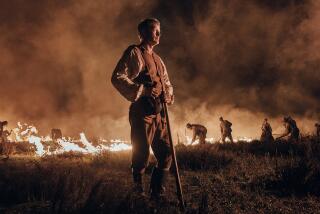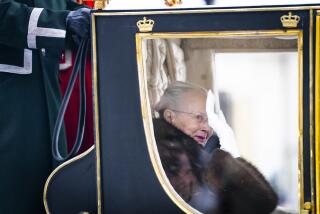Denmark’s Master of the Fairy Tale
- Share via
COPENHAGEN — “To travel is to live,” said Hans Christian Andersen, and this is the year to make his fairy tales part of your travel life.
Commemorating the publication of his first fairy tales 150 years ago, 1986 has been declared Hans Christian Andersen Year in Denmark.
For everyone who has ever been touched by his tales, the sesquicentennial will be a highlight of travels to Europe this year.
As a bonus for travelers eternally young in spirit, the Hans Christian Andersen celebration will climax two years of following fantasy trails during West Germany’s continuing bicentennial for the Brothers Grimm.
The Fairy Tale Festival in Denmark will include exhibitions, sightseeing excursions, films, musicals, performances and readings of Andersen’s works, in Copenhagen and the small city of Odense on the isle of Funen, where he was born in 1805.
Multiple Careers
At age 26, four years before his first slender volume of fairy tales appeared in print, Andersen was already a published poet and successful travel writer and had used teen-age efforts to become part of the Royal Theater in Copenhagen as a stepping stone to a literary career.
When Denmark chose 1986 as Hans Christian Andersen Year, it didn’t really matter that his first book of four “Fairytales for Children” was actually published in 1835. No one year could possibly be enough to commemorate the life and genius of a writer whose works have been translated into more languages than any other writings except the Bible and Shakespeare. One anthology estimates a total of 80 languages.
Japanese tourists already booking tours to Denmark this summer will arrive with copies of books that they have cherished since childhood.
The same poetic flexibility with dates has been happening in West Germany with the bicentennial for the Brothers Grimm and their fairy tales, now into its third year. This celebration began in the summer of 1984, went into high gear for Joseph Grimm’s 200th birth year in 1985 and is continuing with Wilhelm Grimm’s 200th this year.
Andersen Magic
The people of Denmark never miss a chance to honor their teller of fairy tales. We were here in 1975, the 100th anniversary of Andersen’s death, and found that a full summer of commemorative events had been scheduled. That was the year we discovered how much his magic can add to any visit to Denmark. You can use the milestones of his life for your own self-guided tour.
Odense has become an enchanting little fairy-tale city. Each old house along the narrow streets seems sure to have the kind of spinning room and garden in which young Hans listened to Danish folk tales. The small house in which he was born has been made into a museum. Red and white signs giving the number of kilometers to nearby villages also point the way to his birthplace house.
In the Memorial Hall at the entrance is a series of paintings that span his life. They were painted in 1929-32 by Niels Larsen Stevens. Within the low-ceilinged house are the furnishings of the early 19th Century, his manuscripts, drawings, paper cuttings. Here is also the best known of all portraits of the storyteller, painted by C. A. Jensen. In another house nearby, he lived many of his boyhood years.
Folk Tales of His Life
The fabric of these years is laced with folk tales and backstairs gossip. An often-told story is that he was born two months after his 38-year-old washerwoman mother had been married to a 23-year-old cobbler and that his mother was the illegitimate daughter of a woman who once had been sentenced to a week of bread and water in jail after giving birth to three illegitimate children fathered in successive years by different men.
After Hans became famous, many families for whom his mother had worked began to claim him as their illegitimate son. One tangled tale of backstairs lovemaking somehow made him a cousin of Madame Du Barry, mistress of French King Louis XV. For many possible reasons, Hans’ grandfather became mad; Hans went to the asylum with his grandmother to visit him and was terrified by the experience.
Hans’ young cobbler father lived only until Hans was 11 years old. He had served in the Napoleonic wars and was a moody dreamer who read endlessly to his son. Hans’ mother regaled him with peasant folklore and superstitions. When Hans was 14, he told her he was going to Copenhagen. When she asked what he would do there, he replied matter-of-factly, “I shall become famous.”
In addition to the permanent exhibitions around Odense this year, there will be guided and self-guided Fairy Tale Walks in the Footsteps of Hans Christian Andersen from June 15 through Aug. 15. Three- and-four-day Fairy Tale Tours of Funen and nearby isles will also be offered.
Road to a Degree
In Copenhagen, Andersen’s gift of selling himself and his dreams miraculously opened doors to the Royal Theater and even the ballet. But he was so tall and ungainly for his age that no place could be found for him on stage. The best thing that could have happened did happen: a grant that led him, through several Dickensian years, to a university degree.
He was 22 when his first poem, “The Dying Child,” was published. For a time it seemed that Andersen would become best known as a travel writer. In 1829, he published a book about a journey on foot in the countryside. Two years later came his “Rambles in the Romantic Regions of the Harz Mountains.” He then managed to obtain from the King of Denmark a two-year grant for travels in Germany, France, Switzerland and Italy. The Italian background went into his most successful novel, “The Improvisatore.”
After his first book of fairy tales was published, a friend and mentor told him: “Novels will make you famous but fairy tales will make you immortal.” The first four stories are part of growing up for almost every child: “The Princess and the Pea,” “Big Claus and Little Claus,” “The Tinder Box” and “Little Ida’s Flowers.”
Continuing through most of his 70 years, an astonishing total of 168 fairy tales were published. Reach into memory as you are traveling around Denmark and you’re sure to find one that will mean even more this year, be it “The Ugly Duckling,” “The Nightingale,” “The Snow Queen,” “The Little Mermaid” or my own favorite, “The Discontented Fir Tree.” Andersen once wrote: “My tales are for children, but the grown-up person should be allowed to listen as well.”
Mermaid Statue
As you walk around Copenhagen, Edvard Eriksen’s bronze figure of “The Little Mermaid” on her rock at the entrance to the harbor will enchant you to sit near her for a while. She is as sad as she is nubile and lovely, a haunting memory from one of Andersen’s most evocative stories.
There are mementos to his life all around Copenhagen: 6 Vingaardsstraede, the attic room where he lived as a student; 20 Nyhavn, where he wrote his first fairy tales; 18 Nyhavn, where he lived near the end of his life; his statue beside the boulevard named after him, a sculptured figure forever expectantly alive. In the evening, he seems to be looking forward again to the three great love affairs that brought him no lasting happiness, the last with singer Jenny Lind.
In the Workers Museum from June 1 to September there will be a thoughtful exhibition on his life. At the Museum of Theater History in the Parliament Building, an exhibition relating his life to the theater will be presented in July and August, on Wednesdays, Fridays and Saturdays.
It will be difficult to travel anywhere in Denmark without coming upon some commemoration of this Fairy Tale Year. At the Museum of Natural History in Frederiksborg Castle in Hillerod, the most complete collection of Andersen portraits, busts and caricatures will be on display.
In Skaelskor, about an hour from Copenhagen, “The Nightingale” will be performed as a mime play. At the mini-Disneyland of Legoland his fairy tales will be made visual, and “The Swineherd” will be on stage.
Famous Friends
The Fairy Tale Year will be enriched by remembrances of the many lands Andersen visited and the famous people who shared some of his life: Schumann, Liszt, Mendelssohn, Dickens, Heine, Alexander Dumas, Balzac, Ibsen. Flags were displayed in seaports he visited and wrote about in his travel reports as well as novels and fairy tales.
When his 70th birthday was celebrated worldwide in 1875, British newspapers compared him to Shakespeare and Homer. Before his death a few months later, he wrote: “I love life, and life is to rove, to fly with fancy around the earth, for one is soon enough under it.”
For more information to help plan a Fairy Tale visit to Denmark, contact the Danish Tourist Board, 655 3rd Ave., New York 10017, phone (212) 949-2333.
More to Read
Sign up for The Wild
We’ll help you find the best places to hike, bike and run, as well as the perfect silent spots for meditation and yoga.
You may occasionally receive promotional content from the Los Angeles Times.






